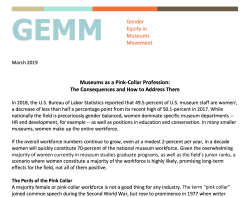How Do You Track Accomplishments and Make Meaning from Them?
Posted: March 4, 2019 Filed under: Creativity, Happiness, Idea flow, Leadership, Museum, museum career, Professional Development | Tags: career, Leadership, museums, nonprofit 4 Comments
When someone asks what you do, what do you say? If you’re a curator, an education curator, a digital curator or museum director how do you explain your job to your great aunt or that family friend whose children are surgeons and investment bankers? And having explained your work life in two sentences and gotten a look of pure puzzlement, do you know what you actually do? By that I mean, do you have any sense of what you accomplish in a given day, week or month?
My colleague Anne Ackerson does. She has an accomplishment jar on her desk. Every time she completes a project or does something worthwhile, she drops a piece of paper in the jar with a note about the accomplishment. On New Year’s day, she re-reads her year through the lens of jobs well done. I am not so organized, but I work for a large organization that requires weekly reports, bi-annual check-ins, and annual performance reviews. But even with all that reporting take it from me: It’s possible to think about your job only in generalities or worse–and this is very, very gendered–to see it only in terms of what you haven’t accomplished. The result? It’s easy to lose sight of what you’ve achieved.
Why is this important? First, seeing progress is a morale boost. At the end of a bad week, it can seem as though the needle never moved, and you accomplished nothing. And that same week can feel so long that activities completed Monday may have disappeared in a fog of what went wrong by Friday. Plus, how often have we talked about leadership and self-awareness in these posts? A lot. And what is an accomplishment review except an acknowledgement of your strengths?
In 2011 two Harvard Business Review researchers, Theresa Amabile and Steven Kramer, looked at how the for-profit world drives innovation. Focused on individuals on the creative side of things, they asked 238 individuals at 26 different companies to answer a daily email about their workday ups and downs. Data from 12,000 emails yielded some important conclusions. First, workers are more creative when they’re happy, and that happiness spills over to colleagues and to the organization itself. Second, they discovered that many of their subjects’ “best days” directly correlated with days when there was perceptible progress on a given project by them or their team.
It’s tempting to conclude that happiness comes with the conclusion of a project–the moment when Anne drops the paper in her Accomplishment Jar–but that’s not what Amabile and Kramer’s work showed. In their study, it was the small wins, the daily movement of the needle that brought happiness. Understanding and charting those small wins over time is important in understanding our own sense of accomplishment.
What can you as an individual do?
- Make a chart: Divide your work life into its major headings–collections care, team management, professional development, and list the things you’ve done each week, month or year. Or just use a jar. But be sure to remember to empty it and read the contents.
- Progress and a sense of accomplishment are intimately linked to creativity. Do you have a job where you check your brain at the door? Then look for ways to raise the creativity quotient. Chart your accomplishments in your off hours–miles run, words written, volunteer hours logged.
And if you’re a leader?
- Check-in on your employees, don’t check-up. Look for what’s holding them back, and see how you can help. Remember that leaders remove barriers. Be a resource not a sheriff.
- See work as iterative. We learn, we accomplish, we get better at what we do. Don’t make one-on-one meetings a laundry list of work yet to be done.
- Use the progress checklist from Amabile and Kramer @ HBR:

Remember this equation: meaningful work+clear and reasonable goals=workplace happiness=creativity= meaningful work.
Yours for accomplishment,
Joan Baldwin










What I find hard to measure in terms of accomplishments is that, as a Collections Manager, many of my tasks are long term some will take years to do and some will never end. How to measure this I am not sure. Even percentages are hard as there are so many unknowns.
For collections managers, you could consider having a floor plan of your collections spaces, and highlight each area you improve (or a graphic with shelf numbers, drawers etc)…it depends on the task. Running an audit report on a database can also give stats about ‘improvements’ to the data that you could chart on a wall poster or something. Instead of tracking ‘finished’ tasks in entirety, I have found breaking them down into more granular ‘what we did’ for ongoing tasks can help give a sense of achievement 🙂
This is a great post. Thanks very much. I think I’ll start an accomplishment jar!
[…] accomplishments: You’ve all probably read about Anne’s accomplishment jar. I am thinking about creating a team accomplishment jar where our program can acknowledge its best […]